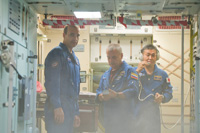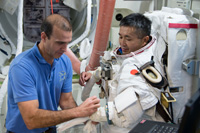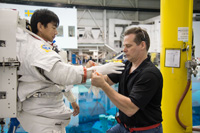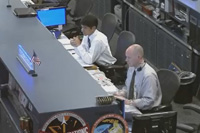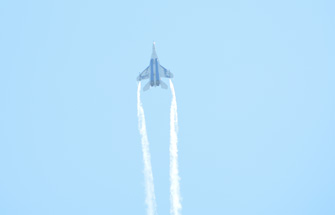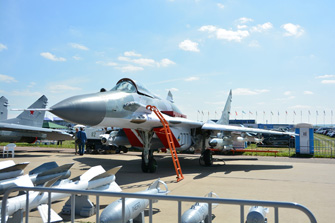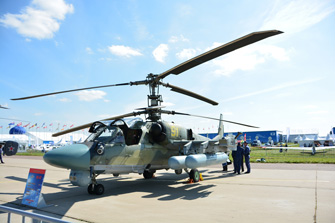【Summary of my last journal entry】The space station transfer vehicle HTV4 (nickname: Kounotori) which was launched from Tanegashima Space Center, progressed smoothly and got to the 30m point below the International Space Station at around 10:30 GMT on the 9th of August. For details, click here.
In the mission control center of the Johnson Space Center in Houston, America, the FCR-1 control room (pronounced ‘ficker-one’) that continuously operates the ISS 24/7/365 is installed with multiple consoles and each of these has its own abbreviation. There is the CAPCOM console that communicates with the ISS where I sit with fellow astronaut Mike Fincke and to the left of that is the Flight console where the ISS flight director, who is in charge of FCR-1, sits and gives directions for the operation of the ISS.
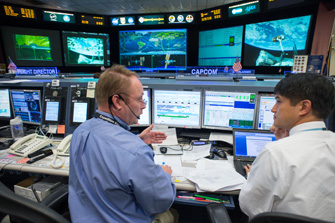
Astronaut Mike Fincke who was in charge of capture communications (the photo is of the HTV separation from the ISS)(Photo: JAXA/NASA)
We are positioned close enough to be able to talk directly to the ISS flight director but we use an audio line to communicate with other consoles. It is possible to simultaneously listen to the various conversations on different lines with the device installed in the console but when I chose the line that the Tsukuba HTV control team uses, I heard familiar Japanese communications. The main person in this communication was the lead flight director for HTV4, Maki Maeda.
She is the person responsible on-site for the operation of the HTV, coordinating cooperation with NASA, preparatory training for the control team and preparation of operations procedures expressly for this day. I had a chance to talk to Maeda-san when she visited Houston a few weeks ago for final adjustments. The nervousness she was talking about then just before the mission seemed hard to believe as she talked in a calm and dignified voice.
The preparation for the final approach of the HTV that had arrived at 30m below the ISS continued. Instructions for the setting of the robot arm console for HTV capture were given from the CapCom microphone to the astronauts on the ISS. As all the screens in the control room were relaying the images of the ISS external camera, it was not possible for us to see the crew directly but the 3 astronauts, including Karen Nyberg who has recently been in charge of capture on the ISS, would have been following these instructions to set up the robot arm console and to double-check the capture procedure and so on.
Each item was properly checked one at a time according to the procedure book. At the control team training in which I participated a number of times, this was the situation that the training instructor team targeted as it was easy for eventualities such as part of the ISS electrical system suddenly shutting down or the camera required for operating the robot arm breaking down to occur. The training instructor team, which is trying to hinder the control team that is trying to achieve capture, feels that this is a fiercely competitive time slot. However, these kinds of malfunctions do not occur so easily in the real world so the time passed without incident.
The confidence of having come through difficult training seemed to pervade the whole control room. The Tsukuba HTV control team was probably the same.
Before long, the crew made contact to say preparation was completed and when checking had finished on the ground, the final approach of the HTV to the ISS began. In other words, the approach to approx. 10m below the ISS. Actual capture was conducted at this point.
The glistening gold of the HTV body became gradually bigger on the screen. I touched on this in my column last month but, it is actually very difficult for the HTV to approach the ISS in a straight line because it is at a different elevation. During this time, the HTV propulsion device should be repeatedly giving out small jets but it seemed so stable on the screen that it was difficult to imagine it moving. In the control room, there was nothing to do but watched over this stage and I was fascinated by the precise approach of the HTV. I honestly thought at that moment that the Japanese technology that made this possible was incredible. A number of controllers took out their cameras and took photos of the HTV on the screen. I could hear voices of wonderment. The NASA specialists, who have led the world in space development, were holding their breath and watching a Japanese spacecraft. I wanted people all over Japan to see this spectacle.
This is a slight digression but I would like to briefly touch on something called orbit dynamics.
Spacecraft including the ISS and the HTV basically fly in a circular orbit with earth at the centre.
If we leave aside difficult calculations and just summarize the main points, the closer the craft is to the earth (low elevation), the faster the air speed is and the further it is away, the slower the air speed is.
If we apply this to the relationship between the ISS and the HTV, the HTV is below the ISS, in other words, the HTV is moving faster than the ISS. This means that if we left the HTV to its own devices, it would gradually edge out in front of the ISS. Therefore, when trying to approach the ISS from underneath in a straight line, it becomes necessary for the propulsion device to send out small jets in the direction that controls this tendency to gradually edge in front.
Sorry, that got a bit complicated... but I would be happy if you were able to understand a little about the technological difficulty of what the HTV is doing. On top of that, I intentionally made things simple this time but trajectory control is much, much more complex in reality!
...Now, let’s get back to the main topic.
The HTV has finally reached the capture point by 11:10. The distance from the ISS was only around 9m ? within waving distance. The screen in the centre of the control room was filled with the image of the HTV sent from the camera attached to the end of the robot arm. And near the centre was the pin that the robot arm would catch. This pin was attached to the surface of the HTV body and capture was achieved by drawing it in to the end of the robot arm.
It was almost impossible to perceive the movement of the HTV on the screen with the naked eye, it was so totally still. I recalled memories of the robot arm training that I underwent last year.
Training in which the robot arm pursued and captured the HTV that moved around a lot on the screen... during that training session, the HTV was just like a runaway horse..(Click here for an example of the training.) What about the real HTV? It was so well-behaved. It was as though it was sitting waiting for capture.
Karen on the ISS must also have undergone that training. And the confidence that she obtained from getting through it must be supporting her now through nervousness of the real operation.
By now, I have already gone over my usual limit for writing but if I say ‘continued next month’ here, I imagine there will be a rush of complaints so I will keep going! Even so, I wonder how many people read my column. It would be good if there were enough people reading to generate a rush of complaints...
Putting that aside...we finally come to the grand HTV capture finale.
A command was sent from the Tsukuba HTV control team. I mentioned before that the robot arm was to capture the pin that is attached to the HTV. In fact, this pin has the function of being able to separate itself from the HTV. If there is a malfunction during the process of the robot arm capturing the pin, it is not possible to continue with capture and usually capture is aborted and the pin is set free but if there is an eventuality in which even that cannot be done, it is a function that is prepared as a last resort to prevent the robot arm from being damaged.
The separation of the pin can only signify the end of the HTV mission. This is because it will never be possible to capture the HTV again.
As it is such an awesome and critical function, usually the function itself is overridden. It is activated just before capture begins.
The last command from the ground before capture was sent. Then the final decision about capture was made in both the HTV and ISS control rooms. Shortly after this, Maeda-san, the HTV flight director contacted the ISS flight director through the audio line and said:
「HTV is GO for capture.」
Having received the go signal from both sides, capture commencement was relayed from the CapCom microphone. When it got to this stage, on the ground there was nothing more to do except watch and wait. Each controller reported the implementation of each procedure that the crew made one by one by attentively observing the on-screen data. Apart from these voices, the control room was completely silent.
‘Switch to robot arm manual mode ? check!’
‘Switch to ISS posture control mode ? check!’
‘Prepare to transition to HTV free drift mode ? check!’
Everyone was watching the screen intently. Then, at last,
‘Robot arm operation commenced.’
We could see the arm begin to move slowly on the centre screen with the images from the camera on the end of the robot arm. It seemed that Karen was first checking the alignment up and down, left and right. Her aim must be to precisely line up with the HTV then to close the distance. Just at that moment...
...all the screens relaying images from the ISS turned blue.
The communication lines that link the ISS and the earth are, in actual fact, not always high-speed. There are certain times when it is not possible to communicate at all and there are other times when communication can only be achieved at a low speed. This is because the part of the US communications satellite network that we use is limited. Usually on days like this when HTV capture and so on are happening, it is arranged in advance that the ISS will have priority use but even then it is not always possible to guarantee high-speed data transmission.
We had come upon one of those times when it was not possible to use high-speed transmission and the live images were not reaching us.
Of course, the control team had expected this and they had even brought the procedures forward a little and, in truth, they had a faint hope that they may be able to see the capture live.
Straight away, the ISS flight director gave instructions to switch the screen display to computer graphics. We did not receive images but we could still receive the necessary data for operation with low-speed transmission so that, on the ground, we were still aware of the position of the robot arm, etc. This data was shown in CG, in other words, it showed us virtual relay images.
Soon the screen was showing the HTV and the robot arm that was slowly moving towards it in CG.
But the sight of the CG was so characterless... To give an example, it’s like when the live coverage of a baseball match stops just when the 4th batter steps up to the plate in the 9th inning with the bases loaded with 2 outs and the team is only 1 point down. And then you hear on the radio that the batter has made a great homerun-like hit and the announcer is yelling, ‘It’s huge...this is huuuuuuge!’ There’s really nothing you can do about it, is there?
The most important thing, after all, was the HTV capture.
Just after that, the crew, who knew nothing of this little drama on the ground, completed the capture perfectly, at 11:22.
‘Pin in robot arm ? check!’
The robot arm controller’s voice conveyed the success of the capture. I could hear the HTV control team applauding in my headset. I am sure that, in the middle of this circle of joy, Maeda-san was smiling with relief.
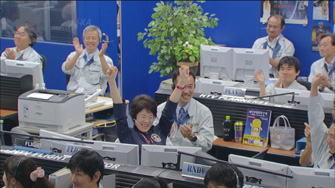
HTV Flight Director Maeda celebrating the successful HTV capture (centre) (Photo: JAXA)
In my mind I was cheering and applauding the great job that my colleagues in Tsukuba had done while also focusing on the second shift of which I would be a member and on which I would be responsible for the joining of the HTV to the ISS.
The mission of the second shift team is to join the HTV that the first shift has captured safely to the ISS and our 9 hour shift to accomplish that was just about to start.
For a video of the capture, click here.

